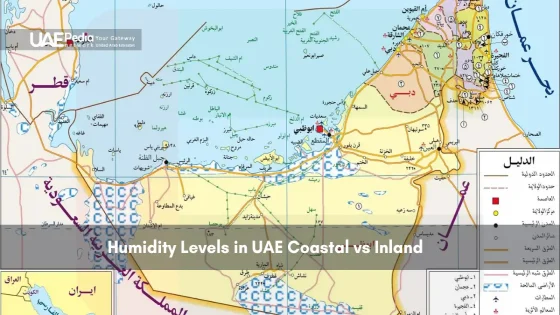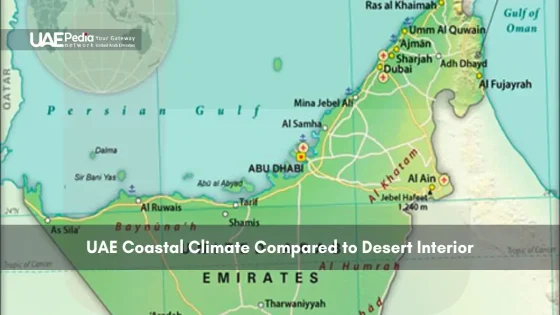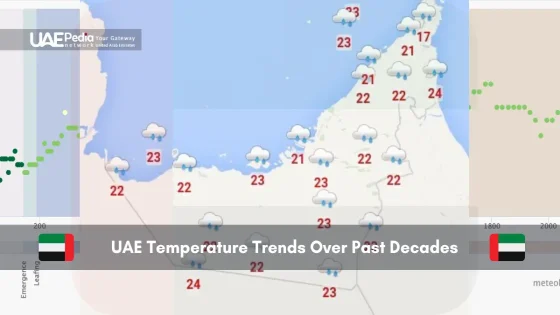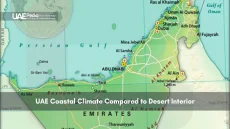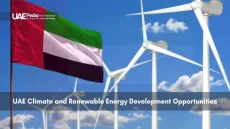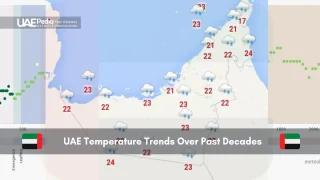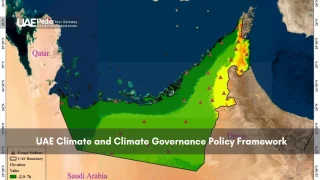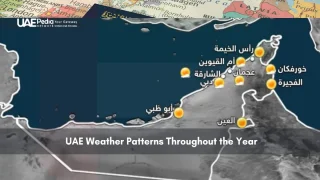Did you know the same warm water temperature that feels refreshing along Abu Dhabi’s corniche can leave you sweating in Sharjah’s suburbs? The Emirates’ geography creates microclimates sharper than a Bedouin’s khanjar – and we’ve got the numbers to prove it.
Using data from the Dubai Meteorological Office and NOAA, we’re mapping how sea breezes battle desert winds across the country. Coastal cities like Dubai enjoy milder afternoons but higher moisture – think 85% vs 45% inland. Meanwhile, Al Ain’s arid heat spikes thermometers 3°C higher than beachfront areas.
This isn’t just about weather reports. We’ll show you why packing linen for Dubai Creek walks but breathable cotton for Liwa Oasis adventures matters. You’ll learn how locals time outdoor activities using seasonal shamal winds and which emirate’s winter feels like eternal spring.
- Coastal zones have 30% more annual humidity but cooler nights
- Inland regions face hotter days (up to 48°C) with rapid evening cooldowns
- December-February offers ideal conditions for desert explorations
Understanding UAE’s Diverse Climate Landscape
Picture this: a land where desert dunes ripple like golden waves toward skyscrapers that kiss salty sea air. The United Arab Emirates’ weather acts like a master chef blending ingredients – coastal breezes, desert heat, and mountain shadows create distinct regional recipes.
Geography’s Weather Whisper
Sea proximity acts like nature’s AC for coastal cities. Abu Dhabi’s average daily maximum of 29°C feels milder than inland areas thanks to Persian Gulf winds. But venture 100km east to Al Ain, and you’ll find desert nights cooling 10°C faster than beachfront zones – like nature flipping a thermostat switch.
Sun & Rain: The Desert’s Dance
May blazes with 11 daily sunshine hours, perfect for Dubai Creek photo ops. Yet January brings surprise guests – about 6 rain days sprinkle the north while southern dunes stay parched. “Our clouds play favorites,” laughs a Dubai-based meteorologist. Coastal fog often battles inland dust storms in a sky ballet you won’t forget.
Here’s what smart travelers track:
- Abu Dhabi’s winter lows (15°C) vs. summer peaks (42°C)
- Sharjah’s 90mm annual rain compared to 60mm in drier regions
- Golden hours: 8am-10am for desert walks before heat soars
These patterns aren’t just data points – they’re your secret map for timing museum visits, desert safaris, and dhow cruises like a seasoned local.
Exploring “Humidity levels in UAE” Across Coastal and Inland Regions
Ever noticed how Dubai Marina’s air clings like a damp scarf while Al Quaa’s heat slaps like a furnace door? The climate patterns here play Jekyll and Hyde across short distances. Let’s unpack what really happens when sea meets sand.
Beachfront Climate Quirks
Coastal cities wear the Persian Gulf like a liquid blanket. August waters hit 32°C – warmer than some swimming pools – creating steamier air. But sea breezes save the day, capping summer highs at 41°C versus inland’s 48°C. “Our humidity feels like a warm hug…that overstays its welcome,” jokes a Dubai surf instructor.
Inland Weather Drama
Drive 90 minutes inland, and the script flips. Relative humidity plunges to 30% as desert winds steal moisture. Nights cool 15°C faster than coastal zones – perfect for stargazing. But days? They’re drier than a ghaf tree’s shadow, with humidity trends showing 67% fewer dewy mornings annually.
Smart explorers track these contrasts:
- Coastal winters: 22°C days with 65% humidity (great for dhow cruises)
- Inland summers: 3% precipitation chance vs 8% near shores
- Annual rainfall: 100mm in northern mountains, 60mm in southern dunes
Whether you’re beach-hopping or dune-bashing, understanding these microclimates turns “Why is my phone overheating?” into “Check my perfect sunset timing!”
Seasonal Variations and Their Impact on Humidity
Imagine stepping from Dubai Mall’s AC chill into July’s oven-like embrace – that’s UAE seasons in a nutshell. The country swings between two main acts: sizzling summers and mild winters, each rewriting the rules of outdoor comfort.
Summer Heat and Elevated Moisture Levels
June-August turns coastal cities into steam rooms. Temperatures regularly hit 43°C (109°F), while humidity clings above 80% – like wearing a wet wool blanket. “Our desert becomes a sauna with occasional sand exfoliation,” quips an Abu Dhabi tour guide. Check these summer standouts:
| Location | Day Temp | Night Humidity | Rain Days |
|---|---|---|---|
| Dubai Coast | 41°C | 85% | 0.2/month |
| Al Ain Desert | 48°C | 32% | 0.1/month |
| Fujairah Mountains | 38°C | 68% | 1.5/month |
Winter Conditions and Reduced Humidity
December-February brings relief. Coastal nights dip to 15°C (59°F) with humidity around 50% – perfect for desert adventures. January sees most rain (6 days average), washing dust from palm fronds. Locals joke: “Winter here is California’s summer – just add camels.”
Smart travelers adjust plans by:
- Booking water activities October-April
- Scheduling indoor tours during July heat peaks
- Packing layers for 20°C daily temperature swings
Data-Driven Insights: Measurements and Climate Indices
Ever wondered why 35°C in Dubai feels like a sauna while the same temperature in Al Ain feels like a dry oven? The answer lies in how we measure atmospheric moisture. Let’s decode the science behind comfort metrics used across the Emirates.
Relative vs Absolute Humidity Explained
Relative humidity measures how much moisture air holds compared to its max capacity – like a sponge’s current wetness. Abu Dhabi’s January average of 67% means air is two-thirds full of water vapor. Absolute humidity counts actual water grams per cubic meter – Dubai’s summer air carries 22g/m³, while desert regions might hold just 8g/m³.
| Location | Relative Humidity (Jan) | Absolute Humidity (g/m³) |
|---|---|---|
| Dubai Marina | 65% | 18 |
| Liwa Desert | 32% | 6 |
| Fujairah Coast | 71% | 21 |
Understanding Humidex and Weather Indexes
The Humidex index combines temperature and dew point to reveal how heat actually feels. When Dubai hits 43°C with 60% humidity? The Humidex screams 52°C – hotter than Death Valley’s dry 46°C. “Our index regularly outperforms thermometers,” notes a National Center of Meteorology specialist.
| City | Temp (°C) | Humidex Value | Comfort Level |
|---|---|---|---|
| Abu Dhabi | 38 | 47 | Dangerous |
| Al Ain | 41 | 44 | Uncomfortable |
| Ras Al Khaimah | 36 | 42 | High Caution |
Smart travelers watch these numbers:
• 40-60% relative humidity = ideal for outdoor activities
• Humidex above 45 = reschedule desert safaris
• Coastal cities average 12 more “sweltering hours” monthly than inland areas
Armed with these metrics, you’ll know why a 28°C day in December feels crisp, while the same temperature in August has you reaching for extra water bottles. Data doesn’t lie – it just needs interpretation!
Final Perspectives on UAE’s Humidity Trends
Picture sipping karak tea as coastal mists swirl around Dubai’s skyscrapers while desert winds whip through Al Ain’s date palms. The Emirates’ weather story unfolds in dramatic contrasts – beachfront breezes spar with inland heat, each chapter written in degrees and dew points.
Decades of climate records reveal sharp patterns. Coastal zones face 80% summer moisture but stay 7°C cooler than desert interiors. Inland areas swing wildly – 48°C daytime peaks plunge to 25°C by midnight. Remember 2017’s record? Al Ain hit 52°C while Fujairah’s mountains stayed a “chilly” 39°C.
Rainfall adds plot twists. Northern regions collect 120mm annually – triple southern deserts. Dubai’s 2020 downpour dumped 130mm in hours, flooding streets but greening wadis. Yet the real star? The Humidex index. It explains why 38°C with 70% moisture feels like 50°C – crucial intel for outdoor plans.
Smart explorers adapt like Bedouins: chase winter’s 22°C desert days, retreat to AC afternoons in July, and always pack layers. Coastal mornings sparkle October-April, while summer shamal winds offer brief respites.
With smart planning – and respect for the data – every sunset becomes a postcard moment here. Whether you’re strolling Abu Dhabi’s Corniche or camping under Liwa’s stars, understanding these rhythms turns climate challenges into Arabian adventures.
Coastal Dubai often sees humidity above 80% in summer, while Abu Dhabi’s inland suburbs like Al Ain experience drier heat (around 50-60%). Both cities face Gulf moisture, but Dubai’s marina areas feel stickier at night due to slower cooling of seawater.
The Arabian Gulf retains daytime heat, releasing moisture after sunset. Urban areas like Dubai Marina amplify this with concrete absorbing warmth—expect “air you can wear” vibes until midnight, especially July-August!
November-March delivers relief! Coastal humidity drops to 60-65%, with Sharjah’s desert parks and Liwa Oasis hikes becoming ideal. Pack layers—winter mornings can dip to 15°C (59°F) inland.
Relative humidity measures moisture in the air compared to its max capacity (think Dubai’s 95% summer mornings). Absolute humidity counts actual water vapor grams per cubic meter—UAE averages 18g/m³ yearly, spiking to 25g/m³ during August sea breezes.
Jumeirah’s beachfront battles 85% humidity in July, while Al Ain’s desert climate sits around 55%—but don’t underestimate the 45°C (113°F) dry heat! Pro tip: coastal fog is common at dawn, inland areas clear faster.
Absolutely! December-February sees Fujairah’s mountains dip to 10°C (50°F) with 40% humidity—perfect for campfires under starry skies. Coastal cities like Umm Al Quwain stay milder, around 20°C (68°F) daytime.
The National Center of Meteorology uses hygrometers at 86 stations nationwide, paired with satellite data. Apps like “UAEWeather” give real-time humidex scores—a combo of heat + moisture that makes 35°C feel like 45°C!
